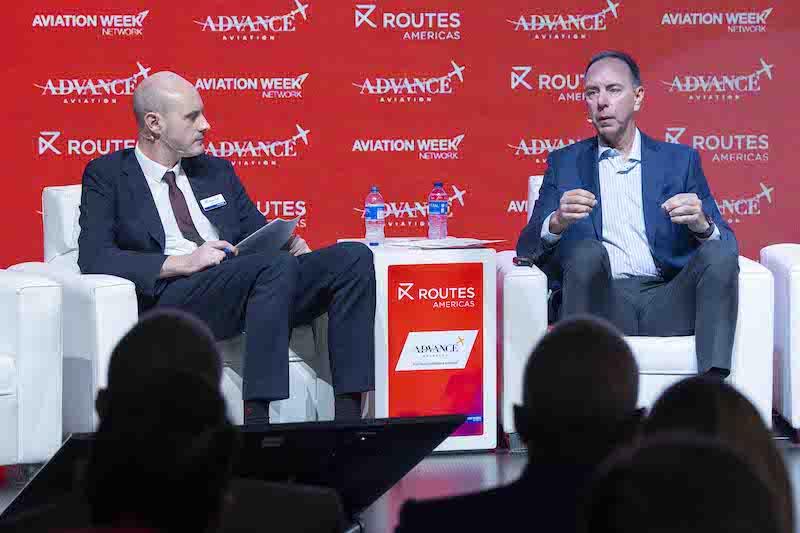IATA’s Cerda: Latin American Airlines’ Traffic Rebound Has Not Translated To Profits

IATA's Peter Cerda (right) speaks on stage with Routes Editor-in-Chief David Casey at Routes Americas 2024 in Bogotá.
BOGOTA—Even as Latin American passenger traffic continues to rebound strongly from the COVID-19 pandemic, the region’s airlines are struggling financially, said Peter Cerda, IATA's regional vice president for the Americas.
During a fireside chat at the Routes Americas 2024 conference here in Bogotá, Colombia, Cerda noted that only African airlines are performing worse financially than Latin American carriers. Passenger traffic in Latin America and the Caribbean was up 4% versus 2019 in 2023, whereas North American traffic was still down 1% from 2019. But North American carriers last year earned a $5.4 post-tax profit per passenger, while Latin American carriers lost $2.5 post-tax per passenger in 2023.
“This year is looking to be another very strong year [in terms of passenger traffic] … but it is a struggling region” financially, Cerda said. “If you look at the state of the industry in Latin America, we have some fantastic airlines in the region, which are really investing in connecting within the region, within the countries and to other parts of the world. But when you look at it from a financial perspective, Latin America is going to continue to struggle. The last time Latin American carriers actually made money was back in 2017.”
More News And Analysis From Routes Americas 2024
Cerda pointed to high taxes on airline flights in the region, which he said puts commercial aviation at a disadvantage compared to buses, which continue to provide the bulk of intercity transportation in Latin America. Bus transportation generally is not taxed or, where taxes are imposed, they are far less than aviation, according to Cerda. “There's no consumer protection, so if the bus breaks down the passenger is really not not given any type of compensation,” he said. “There is no regulatory oversight on it, where aviation is heavily regulated … So, when you look at it, do we have a fair playing field in this region? This is why [Latin American airlines] struggle as a region.”
If governments work with airlines and airports to build aviation capacity and ease taxation, there is enormous potential for growth in Latin America, Cerda said. He noted that out of a population of 216 million people, Brazilians take an average of 0.45 airline trips per year. In contrast, residents of the U.S., which has a population of 334 million, take an average of 2.5 airline trips per year.
In order for Brazil and other Latin American countries to move to similar numbers as the U.S., governments need to partner with airlines to grow traffic, Cerda said, adding that governments in the region need to “start changing their mindset” regarding airlines. “We are not adversaries, and I think many times we look at each other as adversaries.”
Social media has caused government officials in Latin America and elsewhere, including in the U.S. and Canada, to focus on what is wrong with airlines rather than what carriers are doing right, he said, noting this leads to more taxes and regulations that hinder airlines.
“Aviation is very easily criticized on social media, but you don’t see on social media all the great things that happen every day—high performance and nice service,” Cerda explained. “We see the bad, and what the politicians do is they immediately say we’ve got to impose regulations … Latin America is no exception. We're seeing it all across the Americas.”





